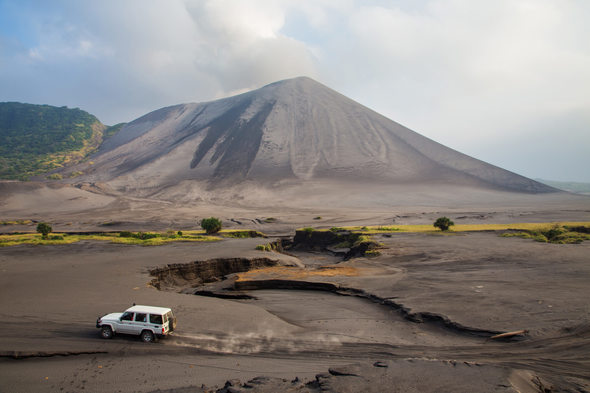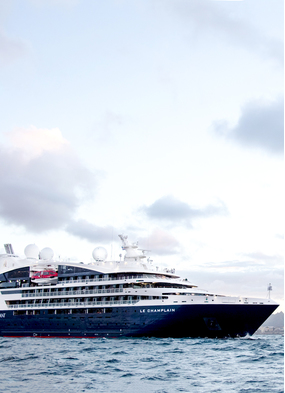Yet there is so much more to this vast region than just sunbathing and snorkelling; the island groups of Melanesia, Micronesia and Polynesia are rich with incredible human stories, and many remain barely touched by tourism. Head a little off the beaten path and you'll find unique tribal societies, fascinating archaeological sites, mysterious 'cargo cults' and islands inhabited by the descendants of shipwrecked sailors.
Independent travel to these islands is complicated and expensive; doubly so if you want to visit several during the course of a single trip. This is where a small ship expedition cruise really comes into its own, allowing you to island-hop across regions with little or no tourist infrastructure, going ashore in zodiac boats and visiting remote communities.
Here are eight of the most remarkable Pacific islands that you can visit on an expedition cruise:
1. Yap, Micronesia
Yap is part of the Federated States of Micronesia, an island republic in the western Pacific, and expedition ships occasionally call at the port of Colonia. Yap is a wonderful island to explore, with its traditional village-based culture and beautiful wooden houses, but perhaps the most extraordinary feature of the island is its giant stone money. Known as Rai, these solid stone discs range from a few centimetres to an astonishing four metres in diameter, and many are too big to move; instead, transactions are agreed verbally and ownership is transferred, without any need to move the stone.

2. Palmerston Island, Cook Islands
European sailors and explorers left a lasting mark on many of the islands of the South Pacific, but few can match the extraordinary claim to fame of William Marsters, a ship's carpenter and barrel maker from Gloucestershire who landed on the coral atoll of Palmerston in 1863. Marsters arrived with two Polynesian wives and later acquired a third on the island, going on to father some 23 children, and the three families who now live on Palmerston are all descended from Marsters, each through a different wife. Marsters is also said to have come up with the unusual name of the popular local fishing spot, Scratch My Arse Rock!

3. Pentecost Island, Vanuatu
Pentecost Island is home to the remarkable ritual known as Gol, or 'land diving', which inspired the extreme sport of bungee jumping. Every year between April and June, a succession of men leap from a precarious-looking wooden tower up to 30 metres high with liana vines wrapped around their ankles, aiming to touch the ground with their head or shoulders. The ritual is believed to ensure a good yam crop - the higher the jump, the better the harvest - and is a rite of passage for local boys on their journey to manhood.

4. Hiva Oa, French Polynesia
Spend a little time on the paradise island of Hiva Oa and you'll soon understand why the artist Paul Gauguin chose to live out his last years here. Gauguin lies in the Calvaire Cemetery, as does the Belgian singer-songwriter Jacques Brel, who also spent his twilight years on this remote island in the southern Marquesas. Of course, the history of these islands goes back much further, and Hiva Oa is home to some fascinating ancient petroglyphs and stone tiki statues.

5. Tanna, Vanuatu
Tanna would be a remarkable island even if it were uninhabited, with its gorgeous beaches and the extremely active volcano Mount Yasur. But what makes the island truly special are its 'cargo cults', local belief systems which venerate the modern goods of more technologically advanced societies as gifts from the gods. One such example is the John Frum movement, which is believed to have originated with an encounter between islanders and an American serviceman named John. Even more extraordinary is the Prince Philip Movement, which reveres our own Duke of Edinburgh as a divine being! (For a unique insight into this culture, it's worth digging out Channel 4's 2007 documentary 'Meet the Natives').

6. Robinson Crusoe Island, Chile
Far to the east of the Polynesian islands, 400 miles off the Pacific coast of Chile, lies the Juan Fernández archipelago, a sparsely inhabited group of volcanic islands with less than 1,000 permanent inhabitants. Robinson Crusoe Island is so named as this was where the Scottish sailor Alexander Selkirk was marooned from 1704 to 1709, believed to be the real life inspiration for Daniel Defoe's famous novel. The island is also a UNESCO Biosphere Reserve, home to an extraordinary number of endemic plant species and wildlife including Magellanic penguins, fur seals and the Juan Fernández firecrown, a critically endangered species of hummingbird.

7. Dobu, Papua New Guinea
Dobu is part of the D'Entrecasteaux group of islands, and was once feared by outsiders as a hotbed of witch doctors and black magic, documented in the anthropologist Reo Fortune's 1930 book 'The Island of Sorcerers'. The island is also part of the famous Kula Ring, a fascinating and unique ceremonial practice in which the inhabitants of 18 different islands exchange armbands and necklaces. The Kula system is complex, linked to both political authority and social hierarchy, and involves treacherous expeditions by canoe that help to bring these remote island communities together through trade.

8. Pohnpei, Micronesia
Just off the coast of Pohnpei lie the ruins of Nan Madol, one of the world's most fascinating and enigmatic ancient cities, though few people have even heard of it. Nan Madol is made up of around 100 man-made islets, littered with the remnants of stone temples, palaces and tombs built during the 13th and 14th centuries. The city was the capital of the Saudeleur Dynasty, and is sometimes known as the 'Venice of the Pacific' due to the canals that connected the islands together. Nan Madol has also been linked to the mythical lost continent of Lemuria, and was the inspiration for the city of R'lyeh in H.P. Lovecraft's short story 'Call of Cthulu'.










